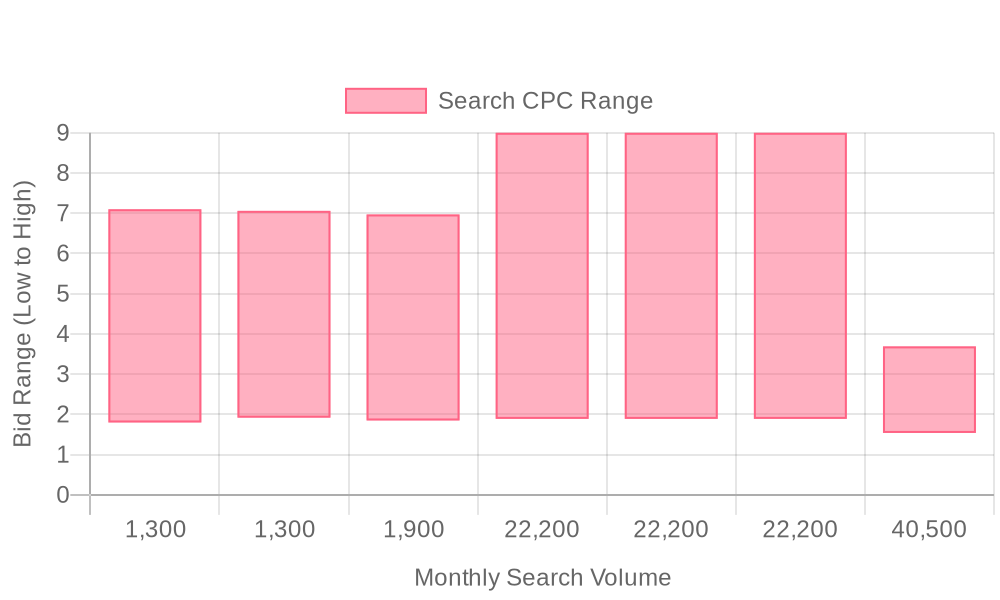
Supercharge your lead generation with a FREE Google Ads audit - no strings attached! See how you can generate more and higher quality leads
Get My Free Google Ads AuditFree consultation

No commitment
Supercharge your lead generation with a FREE Google Ads audit - no strings attached! See how you can generate more and higher quality leads
Get My Free Google Ads AuditFree consultation

No commitment
Navigating the complex landscape of Google Ads for the aerospace industry requires understanding how to strategically harness digital platforms to elevate your brand and generate leads. Aerospace businesses face unique marketing challenges such as targeting specialized audience segments, leveraging industry-specific terminologies, and integrating with specialized marketing tools. One common issue is the lack of visibility into anonymous traffic which can leave potential leads unnoticed. Advanced tools now enable aerospace companies to identify these valuable prospects, aiding in maximizing ad spend by focusing on high-intent individuals. In this guide, we discuss effectively integrating Google Ads into your marketing strategy, addressing key pain points, and optimizing for the aerospace sector. Utilizing solutions that provide actionable insights allows for a data-driven approach to transforming advertising efforts.

Aerospace companies face unique challenges in digital marketing: lengthy sales cycles, technical audiences, and stringent compliance requirements. Leveraging Google Ads for Aerospace Industry enables marketing teams to reach high-intent decision-makers during critical research and procurement phases, accelerating lead acquisition and increasing the efficiency of every ad dollar spent.
Industry leaders in aerospace marketing rely on precise targeting and conversion-oriented strategies to stay ahead. Real-time intent data and advanced audience segmentation transform anonymous traffic into actionable leads, empowering teams to prioritize accounts showing true buying signals and optimize budget allocation for maximum ROI.
Aerospace industry marketing demands granular keyword research. Teams should focus on a mix of high-intent long-tail keywords—such as “AS9100-certified aerospace machining” or “ITAR-compliant avionics supplier”—and sector-specific terms identifying critical pain points. Negatives like “jobs” or “training” filter out irrelevant clicks, ensuring budgets target only buyers and procurement professionals. With enriched data platforms, marketers can cross-reference aerospace industry keywords and historical performance, refining keyword lists to capture in-market accounts at the right stage.
B2B aerospace advertising thrives on reaching the right personas: procurement managers, technical evaluators, and compliance officers. Audience segmentation combines job titles, company lists, and intent signals from website activity or CRM data. As leads engage with content—downloading spec sheets, requesting quotes, or attending webinars—dynamic audience segments automatically update, allowing marketers to serve tailored ads and nurture prospects as they move through the funnel. This approach ensures no high-value account is missed, and retargeting efforts are always relevant.
Each campaign type can be enhanced by integrating CRM and website engagement data, ensuring ads reach decision-makers and influencers with the most up-to-date messaging and offers.
Effective aerospace ad campaigns hinge on landing pages that communicate credibility, technical capability, and compliance. Use clear headlines referencing certifications, customer logos from past contracts, and concise proof points. Embedded lead forms should sync seamlessly with your CRM, ensuring rapid and personalized follow-up. Creative assets—such as 3D renderings, facility tours, and case study videos—help reinforce trust and differentiate your solution in a crowded field.
Continuous optimization is the backbone of successful PPC for aerospace. Advanced conversion tracking—spanning online and offline interactions—provides a unified view of campaign impact. By connecting ad click data with CRM and sales outcomes, marketers can pinpoint which keywords, audiences, and creative assets drive true revenue. Real-time analytics identify high-converting accounts, allowing teams to shift spend toward what works and pause underperforming segments. This data-driven feedback loop drives sustained improvements in lead quality and cost efficiency across all aerospace ad campaigns.
Ready to accelerate your aerospace lead generation? Get started for free with Sona.

Digital marketing in the aerospace sector faces unique obstacles: long sales cycles, complex buying committees, and highly specialized solutions. Google Ads offers a direct path to engage high-value decision makers—manufacturers, engineers, and procurement specialists—at critical moments in their research and vendor evaluation journeys. This targeting precision is essential in a market where missed connections often mean missing out on multi-million-dollar contracts. For a comprehensive overview of lead generation strategies tailored to this sector, see this lead generation for aerospace guide.
Aerospace companies leverage Google Ads to promote high-margin services and innovative technologies to the exact audience segments that influence purchasing outcomes. By reaching technical evaluators and procurement teams as they search for compliance-driven solutions, organizations can differentiate their offerings and position themselves as credible industry leaders. For more on optimizing your campaigns, explore Google Ads best practices.
Precision targeting through Google Ads enables aerospace firms to expand visibility in emerging markets and niche verticals that traditional channels often overlook. With tailored keyword strategies and custom audience segments, marketers can reach underrepresented buyers—such as new OEM entrants, MRO providers, or regional operators—accelerating growth in previously untapped areas. This approach also supports global expansion initiatives, helping brands localize messaging and comply with regional regulations.
Integrated analytics and conversion tracking in Google Ads provide much-needed clarity on true marketing ROI in the aerospace industry. By linking online actions—such as ad clicks and form submissions—to offline outcomes like contract signings or RFQ responses, marketers can attribute revenue to specific campaigns and optimize spend accordingly. Platforms with advanced identification and real-time audience capabilities enable revenue teams to move beyond anonymous traffic, pinpointing the companies behind high-value engagements and adjusting budgets to focus on accounts most likely to convert. Real-time CRM and ad audience sync ensures that as leads progress through the pipeline, campaigns stay relevant and high-performing, closing the loop between marketing activities and business outcomes. Ready to see how this could work for you? Get started for free with Sona.

B2B aerospace marketers require campaign structures that precisely map to each phase of the buying journey, from initial research to post-demo nurturing. Selecting the right Google Ads format is critical for maximizing ROI, ensuring compliance signals are visible, and driving measurable engagement within highly specialized buying committees. Below, each campaign type is detailed for its application in aerospace sector advertising, with an emphasis on how advanced data integration and audience intelligence drive superior results.
By deploying these diverse campaign types in a unified strategy, aerospace marketers can orchestrate highly personalized, data-driven digital marketing campaigns that reach, influence, and convert their most valuable prospects at every stage of the buying journey. Get started for free with Sona.
Expanding growth in the aerospace sector requires a precise approach to digital marketing. Aerospace companies targeting specialized buyers and complex supply chains benefit most from actionable PPC strategies that adapt to evolving market demands. For an industry-specific overview, see this lead generation for aerospace resource, and explore additional tactics in our actionable playbooks for demand generation.
Synchronizing CRM and ad data closes the loop by ensuring new leads from PPC efforts flow directly into aerospace sales workflows. This seamless connection helps revenue teams react quickly to high-intent signals, personalize outreach, and measure return on investment with full-funnel attribution—essential for maximizing growth across the aerospace value chain. Ready to streamline your aerospace marketing? Get started for free with Sona.

Audience segmentation is the backbone of highly effective aerospace sector advertising. By structuring campaigns around distinct buyer profiles, marketers can serve relevant messaging, optimize ad spend, and drive stronger pipeline outcomes. Precision targeting in aerospace digital marketing ensures every impression is tailored to the decision-makers most likely to engage, whether they're evaluating MRO services or advanced avionics systems. For a deeper dive into lead generation strategies in this industry, see lead generation for aerospace.
To maximize results, start by clearly defining core audience segments. Separate commercial aerospace companies from military contractors, as each group has differing priorities, compliance expectations, and procurement cycles. Commercial buyers often seek cost efficiency, sustainability, and scalability, while military segments value security clearance, regulatory certifications, and government contract experience. Building these profiles into your strategy enables ad groups to reflect the specialized language and compliance cues each audience expects.
Overlaying key intent signals further refines your targeting. Monitor which accounts are investing in new technologies, researching upcoming RFPs, or actively engaging with aerospace industry marketing content. This allows marketers to move beyond surface-level demographics and tap into behavioral data, identifying visitors who are actively in-market but might otherwise remain anonymous. With platforms that unify go-to-market data, B2B teams can pinpoint high-value companies and allocate budget toward those demonstrating strong buying intent in real time. This approach dramatically limits wasted impressions and ensures messaging aligns with prospects’ current needs and interests.
Customizing ad groups and creative assets is essential for segmented messaging paths. Dynamic audience rules keep segments up to date as leads progress from awareness to consideration and intent. As aerospace prospects interact with site content or download technical documentation, audiences are automatically refreshed, allowing for timely, personalized follow-up. Integration with CRM and sales systems ensures that enriched audience data syncs directly into Google Ads and other platforms, streamlining remarketing to key accounts and aligning sales and marketing outreach. This seamless connectivity empowers teams to execute highly targeted aerospace ad campaigns that adapt as prospects move through the funnel, resulting in higher engagement and improved conversion rates. To see how this works in practice, get started for free with Sona.

| Industry | Keyword | Monthly Search Volume | Competition Level | Low Bid | High Bid |
| Aerospace Industry | aerospace manufacturing company | 1300 | LOW | 1.8 | 7.1 |
| Aerospace Industry | aerospace welding | 1300 | LOW | 1.92 | 7.06 |
| Aerospace Industry | aerospace industry | 1900 | LOW | 1.85 | 6.97 |
| Aerospace Industry | aerospace companies | 22200 | LOW | 1.89 | 9 |
| Aerospace Industry | aerospace manufacturing co | 22200 | LOW | 1.89 | 9 |
| Aerospace Industry | aerospace manufacturing | 22200 | LOW | 1.89 | 9 |
| Aerospace Industry | aerospace | 40500 | LOW | 1.54 | 3.69 |
An effective keyword strategy for the aerospace industry focuses on intent-rich, sector-specific queries that signal procurement readiness. Aerospace buyers often use highly technical search terms reflecting their stage in the purchasing process, such as “AS9100 certified aerospace machining” or “satellite component suppliers for defense contracts.” These queries reveal high conversion potential, allowing marketers to allocate budget to audiences most likely to convert. For a detailed breakdown of effective aerospace lead generation approaches, review this overview of lead generation strategies for aerospace and explore our guide to account identification for further targeting insights.
When leveraging Google Ads for Aerospace Industry campaigns, marketers can use visitor identification to pinpoint companies and decision-makers behind high-intent searches, rather than relying solely on anonymous click data. Real-time intent monitoring enables immediate budget shifts to capitalize on in-market accounts, while dynamic audience updates ensure that as prospects progress through the funnel, messaging and offers remain relevant. Integration with CRM systems allows enriched keyword audiences to sync seamlessly with sales and marketing workflows, aligning ad targeting with real opportunities and delivering measurable impact across the aerospace sector’s complex sales cycles. To experience these capabilities firsthand, get started for free with Sona.
Precision and alignment in campaign execution are fundamental to driving measurable results in the aerospace sector. Each step in the framework builds on proven strategies that address the industry’s unique challenges: lengthy buying cycles, high-value deals, and stringent compliance requirements. By integrating actionable market insights with advanced Google Ads tactics, aerospace marketers elevate their digital marketing aerospace performance and maximize ROI.
Develop comprehensive keyword lists that reflect the technical language and intent of aerospace buyers. Start by segmenting keywords across primary service categories such as avionics integration, MRO (maintenance, repair, and overhaul), or aerospace engineering solutions. For a deeper dive into top-performing terms, review a list of popular aerospace-related keywords. Enrich these lists with high-intent modifiers like “ITAR certified,” “military grade,” or “FAA approved” to focus spend on prospects further along the buying journey. Incorporate location-based terms to capture regional searches and government contract opportunities, ensuring visibility for both local and global procurement managers.
Leverage intent signals from historical search behavior and CRM data to identify new, high-converting keyword clusters. When visitor identification technology links anonymous traffic to actual company accounts, it reveals which organizations are researching specific aerospace solutions. This data-driven approach to keyword expansion enables marketers to anticipate shifts in demand and prioritize spend on keywords that correlate with in-market accounts, driving more qualified traffic to aerospace ad campaigns.
Craft ad copy that addresses aerospace industry pain points with clarity and authority. Highlight critical differentiators such as compliance credentials, past performance with major agencies, or certifications like AS9100 and CMMC. Use concise language to emphasize reliability, security, and technical expertise—qualities that resonate with procurement and engineering stakeholders. To inspire your creative process, explore effective Google Ad examples and consider referencing your own case studies and proof points within the ad copy. Dynamic ad elements, including sitelinks to case studies and callouts for contract vehicles (e.g., “GSA Schedule Holder”), increase click-through rates by offering immediate proof of trust.
Integrate real-time intent data into ad messaging. As new high-value companies engage with landing pages or product demos, update ad copy to reflect the latest customer use cases and success stories. This approach ensures that advertising remains relevant and persuasive as lead profiles evolve throughout the campaign.
Ensure seamless continuity between ad messaging and landing page content to reinforce trust and reduce friction in the conversion process. Each ad group should direct clicks to a landing page tailored to the specific aerospace service, certification, or contract type promoted in the ad. For example, an ad targeting “CMMC-compliant avionics” must lead to a page detailing the organization’s CMMC processes, audit history, and secure supply chain practices.
Implement dynamic content blocks that personalize the landing page based on visitor industry, job title, or company. When enriched audience data flows from CRM systems into the digital experience, marketers can dynamically serve testimonials, case studies, or product specs that mirror the prospect’s sector and needs. For additional ideas on aerospace campaign planning, see these insights on aerospace marketing. This 1:1 alignment significantly increases engagement and conversion rates across PPC for aerospace campaigns.
Use comprehensive analytics to continuously refine targeting, bidding, and creative strategies throughout the campaign lifecycle. Monitor engagement metrics such as time on site, qualified lead conversion, and RFP downloads to identify drop-off points and areas for improvement. Advanced conversion tracking links both online and offline actions—including phone calls, demo requests, and signed contracts—providing a holistic view of campaign ROI.
Sync audience and lead data across Google Ads and CRM platforms to maintain up-to-date targeting lists as prospects move through the funnel. For best practices on optimizing your campaigns, review this comprehensive guide to Google Ads management. When high-intent leads progress from research to procurement, update ad audiences and retargeting segments in real time. This iterative approach allows for agile budget allocation, ensuring more investment is directed toward accounts and personas with the strongest buying signals. For aerospace marketers ready to take the next step, get started for free with Sona to unlock your campaign’s full potential.

Aerospace organizations achieve sustained growth by cultivating a presence that engages decision-makers and influencers at every point in the buyer journey. Smart digital strategies prioritize connecting with high-intent prospects, accelerating pipeline velocity, and building enduring brand authority. To maximize these efforts, leverage real-time audience segmentation to reach the right stakeholders with targeted messaging as they progress through the funnel.
Embracing Google Ads for Aerospace Industry as a core channel requires a sophisticated, data-driven approach. By integrating advanced analytics, marketers bridge the gap between digital interactions and business outcomes, ensuring every audience segment receives personalized, relevant messaging at the optimal moment. This unification of intent data, CRM signals, and campaign performance empowers teams to act on the most urgent opportunities and measure the true ROI of every aerospace sector advertising initiative. For a deeper understanding of how to align digital ad execution with holistic aerospace industry marketing, explore our blog’s aerospace marketing strategies or get started for free with Sona to transform disconnected touchpoints into a seamless, revenue-producing funnel.
Navigating the intricacies of Google Ads in the aerospace industry requires a strategic approach tailored specifically to this dynamic sector. By understanding the unique challenges and opportunities that come with advertising in this field, you position yourself to effectively reach your target audience and achieve your marketing objectives.
Throughout this article, we've explored key strategies for optimizing your Google Ads, from selecting the most relevant keywords to crafting compelling ad copy that resonates with potential customers. The aerospace industry, with its specialized language and customer base, demands a nuanced approach to digital marketing, and these insights aim to equip you with the tools needed to succeed.
Embrace the opportunity to transform your digital marketing efforts by leveraging these strategies. With dedication and the right tools, you can enhance your brand's visibility and engagement in the aerospace sector, ultimately driving growth and innovation. Take the first step towards a more impactful advertising strategy and see the difference targeted, data-driven insights can make.
Experience the benefits firsthand. Start for free to explore our platform and discover how it can elevate your advertising efforts in the aerospace industry.
The best keywords focus on high-intent, sector-specific queries such as 'AS9100-certified aerospace machining' or 'ITAR-compliant avionics supplier,' which signal procurement readiness and conversion potential.
Aerospace companies can use Google Ads by targeting specialized audience segments, leveraging industry-specific terminologies, and integrating advanced tools for actionable insights to optimize ad spend and reach high-intent decision-makers.
Common challenges include lengthy sales cycles, technical audiences, stringent compliance requirements, and lack of visibility into anonymous traffic, which can lead to unnoticed potential leads.
Aerospace companies should track metrics such as engagement, qualified lead conversion, RFP downloads, and connect ad click data with CRM and sales outcomes to measure campaign impact.
Google Ads offers precise targeting to engage high-value decision makers at critical moments, essential in aerospace for differentiating offerings and capturing multi-million-dollar contracts, unlike some traditional channels.
Join results-focused teams combining Sona Platform automation with advanced Google Ads strategies to scale lead generation

Connect your existing CRM

Free Account Enrichment

No setup fees
No commitment required

Free consultation

Get a custom Google Ads roadmap for your business
Join results-focused teams using Sona Platform automation to activate unified sales and marketing data, maximize ROI on marketing investments, and drive measurable growth

Connect your existing CRM

Free Account Enrichment

No setup fees
No commitment required

Free consultation

Get a custom Google Ads roadmap for your business
Over 500+ auto detailing businesses trust our platform to grow their revenue
Join results-focused teams using Sona Platform automation to activate unified sales and marketing data, maximize ROI on marketing investments, and drive measurable growth

Connect your existing CRM

Free Account Enrichment

No setup fees
No commitment required

Free consultation

Get a custom Google Ads roadmap for your business
Over 500+ auto detailing businesses trust our platform to grow their revenue
Join results-focused teams using Sona Platform automation to activate unified sales and marketing data, maximize ROI on marketing investments, and drive measurable growth

Connect your existing CRM

Free Account Enrichment

No setup fees
No commitment required

Free consultation

Get a custom Google Ads roadmap for your business
Over 500+ auto detailing businesses trust our platform to grow their revenue
Join results-focused teams using Sona Platform automation to activate unified sales and marketing data, maximize ROI on marketing investments, and drive measurable growth

Connect your existing CRM

Free Account Enrichment

No setup fees
No commitment required

Free consultation

Get a custom Google Ads roadmap for your business
Over 500+ auto detailing businesses trust our platform to grow their revenue
Our team of experts can implement your Google Ads campaigns, then show you how Sona helps you manage exceptional campaign performance and sales.
Schedule your FREE 15-minute strategy sessionOur team of experts can help improve your demand generation strategy, and can show you how advanced attribution and data activation can help you realize more opportunities and improve sales performance.
Schedule your FREE 30-minute strategy sessionOur team of experts can help improve your demand generation strategy, and can show you how advanced attribution and data activation can help you realize more opportunities and improve sales performance.
Schedule your FREE 30-minute strategy sessionOur team of experts can help improve your demand generation strategy, and can show you how advanced attribution and data activation can help you realize more opportunities and improve sales performance.
Schedule your FREE 30-minute strategy sessionOur team of experts can help improve your demand generation strategy, and can show you how advanced attribution and data activation can help you realize more opportunities and improve sales performance.
Schedule your FREE 30-minute strategy session





Launch campaigns that generate qualified leads in 30 days or less.
